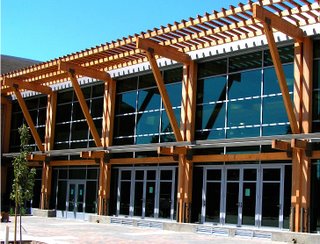 Solar power has received a strong endorsement from the government here in California. The goal is to place electricity generating solar panels, referred to as photovoltaics or PV, on one million roofs in the state. Large rebates are being offered bring down the cost and encourage the purchase of systems. Our governor's vision is to make California a world-wide leader in solar power. Currently Japan and Germany, are the world leaders in solar power.
Solar power has received a strong endorsement from the government here in California. The goal is to place electricity generating solar panels, referred to as photovoltaics or PV, on one million roofs in the state. Large rebates are being offered bring down the cost and encourage the purchase of systems. Our governor's vision is to make California a world-wide leader in solar power. Currently Japan and Germany, are the world leaders in solar power.
The question on people's minds-- is PV practical for the average homeowner or small business operator? While most people support PV,, on a gut level, when they price the systems, often $10-20,000 installed, they begin to question if it makes sense. Without rebates, the payback time (meaning the time it takes for the electricity savings to equal the PV cost), can be over 12 years. A fifty percent rebate can half that number and many states in addition to California offer incentives.
The best analysis is not just a simple financial payback, but a careful consideration of all the factors. First of all, payback time is based on an estimate of the future inflation of electricity costs. Owning a PV system insulates you from rising electricity costs and provides security knowing that future electricity costs won't be affecting you much if all (some PV systems provide all of a home's electricity needs while others may supply only a certain percentage). While PV life expectancies are rated at around 25 years, many feel they will last up to 50 years. Assuming you stay in your home, free electricity in one's older years can be quite a relief. Even if you move from your home, the solar panels can add value beyond their actual cost when you sell.
One of the beautiful features of solar is that it produces the most electricity during the middle of the day when there is the biggest demand. Many electrical rates are moving toward time of use pricing where the rates are much higher in the middle of the day. With PV you can consume electricity during the peak periods without added costs or increasing overall demands which requires new power plants to be built. You help your state without having to turn down your air conditioner or turn off your appliances during the hottest part of the day. Additionally, you won't have to worry about utility company blackouts with your own generation of electricity.
How much value do you place on being part of the solution instead of part of the problem? How much is doing the right thing worth? Do you ever donate to charity? Even if you don't see an actual financial return on PV at this time, you will become a better citizen with PV. You will stop contributing to global climate change when you use electricity. You will support the growth of the renewable energy industry. You will be able to look young children in the eye and know that you are contributing to their future.
Many are waiting for future improvements in the solar industry that will increace efficiency and drive down costs. So, shouldn't you wait? No. There doesn't seem to be any great technological advances in the short term that will dramatically change the industry. Yes, there is a lot of research on many great new ideas for solar from flexible plastics to nano-technology, but these are probably many years out before they are readily available and affordable. Also, as technology advances and prices come down, the government incentives will fade away. If you live in California, now is definitely the time to seriously consider PV for your home or business.
 The green building movement is exploding with growth. Local governments everywhere are incorporating green concepts into regulations and guidelines. San Francisco is soon to host West Coast Green, the largest green building conference with 250 exhibitors and dozens of speakers.
The green building movement is exploding with growth. Local governments everywhere are incorporating green concepts into regulations and guidelines. San Francisco is soon to host West Coast Green, the largest green building conference with 250 exhibitors and dozens of speakers.






